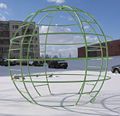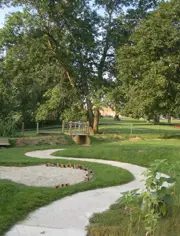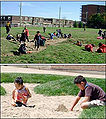Difference between revisions of "Playground" - New World Encyclopedia
Nick Perez (talk | contribs) |
|||
| Line 3: | Line 3: | ||
[[Image:PlayEquipComboPlastic wb.jpg|right|thumb|Combination playground structure for small children; slides, climbers (stairs in this case), playhouse]] | [[Image:PlayEquipComboPlastic wb.jpg|right|thumb|Combination playground structure for small children; slides, climbers (stairs in this case), playhouse]] | ||
| − | A '''playground''' or '''play area''' is an area designed for [[child]]ren to play freely | + | A '''playground''' or '''play area''' is an area designed for [[child]]ren to play freely, usually part of a school or public park. Playgrounds often also have facilities for playing informal games of adult [[sport]]s, such as a [[baseball]] diamond, a [[skating]] rink, a [[basketball]] court, or a [[tether ball]]. |
| − | |||
| − | |||
| − | |||
| − | Playgrounds often also have facilities for playing informal games of adult [[sport]]s, such as a [[baseball]] diamond, a [[skating]] rink, a [[basketball]] court, or a [[tether ball]]. | ||
"Public" playground equipment refers to equipment intended for use in the play areas of [[park]]s, [[school]]s, child care facilities, institutions, multiple family dwellings, restaurants, resorts, and recreational developments, and other areas of public use. | "Public" playground equipment refers to equipment intended for use in the play areas of [[park]]s, [[school]]s, child care facilities, institutions, multiple family dwellings, restaurants, resorts, and recreational developments, and other areas of public use. | ||
| Line 14: | Line 10: | ||
==About playgrounds== | ==About playgrounds== | ||
| + | |||
| + | Modern playgrounds often have recreational equipment such as the [[see-saw]], [[merry-go-round]], [[swing (seat)|swingset]], [[Playground slide|slide]], [[climber (playground)|climber]], [[walking bridge]], [[jungle gym]], [[chin-up bar]]s, [[sandbox]], [[spring rider]], [[monkey bars]], [[overhead ladder]], [[trapeze]] rings, [[playhouse]]s, and [[maze]], many of which help children develop physical coordination, strength, and flexibility, as well as providing [[recreation]] and [[enjoyment]]. Common in modern playgrounds are "[[play structures]]" that link many different pieces of equipment. | ||
| + | |||
Professionals recognize that the [[social skills]] that children develop on the playground become lifelong skill sets that are carried forward into their adulthood. Independent research concludes that playgrounds are among the most important environments for children outside the home. Most forms of play are essential for healthy development, but free, spontaneous play—the kind that occurs on playgrounds—is the most beneficial type of play. | Professionals recognize that the [[social skills]] that children develop on the playground become lifelong skill sets that are carried forward into their adulthood. Independent research concludes that playgrounds are among the most important environments for children outside the home. Most forms of play are essential for healthy development, but free, spontaneous play—the kind that occurs on playgrounds—is the most beneficial type of play. | ||
Revision as of 21:03, 9 June 2008
A playground or play area is an area designed for children to play freely, usually part of a school or public park. Playgrounds often also have facilities for playing informal games of adult sports, such as a baseball diamond, a skating rink, a basketball court, or a tether ball.
"Public" playground equipment refers to equipment intended for use in the play areas of parks, schools, child care facilities, institutions, multiple family dwellings, restaurants, resorts, and recreational developments, and other areas of public use.
A type of playground called a playscape is designed to provide a safe environment for play in a natural setting.
About playgrounds
Modern playgrounds often have recreational equipment such as the see-saw, merry-go-round, swingset, slide, climber, walking bridge, jungle gym, chin-up bars, sandbox, spring rider, monkey bars, overhead ladder, trapeze rings, playhouses, and maze, many of which help children develop physical coordination, strength, and flexibility, as well as providing recreation and enjoyment. Common in modern playgrounds are "play structures" that link many different pieces of equipment.
Professionals recognize that the social skills that children develop on the playground become lifelong skill sets that are carried forward into their adulthood. Independent research concludes that playgrounds are among the most important environments for children outside the home. Most forms of play are essential for healthy development, but free, spontaneous play—the kind that occurs on playgrounds—is the most beneficial type of play.
Children have devised many playground games and pastimes. But because playgrounds are usually subject to adult supervision and oversight, young children's street culture often struggles to fully thrive there. Research by Robin Moore (Childhood's Domain: Play and Place, 1986) has clearly shown that playgrounds need to be balanced with marginal areas that (to adults) appear to be derelict or wasteground but to children they are area's that they can claim for themselves, ideally a wooded area or field.
A type of playground called a playscape can provide children with the necessary feeling of ownership that Moore describes above. Playscapes can also provide parents with the assurance of their child's safety and wellbeing, which may not be prevalent in an open field or wooded area.
Playgrounds can be
- Built by collaborative support of corporate and community resources to achieve an immediate and visible "win" for their neighborhood.
- Public, free of charge, like at most rural elementary schools
- A business with an entrance fee
- Connected to a business, for customers only, e.g., at McDonald's and IKEA.
- Elaborate indoor mazes, like those at the (now defunct) Discovery Zone and Chuck E. Cheese's
Playground safety
Sometimes the safety of playgrounds is disputed in school or among regulators. Over at least the last twenty years, the kinds of equipment to be found in playgrounds has changed, often towards safer equipment built with modern materials. For example, an older jungle gym might be constructed entirely from steel bars, while newer ones tend to have a minimal steel framework while providing a web of nylon ropes for children to climb on. Often, playgrounds with equipment that children may fall off of has mulch on the ground to help break children's falls. Rubber mulch is gaining popularity due to its added ability to break falls.
A study done by the Canadian Institute for Health Information found that playground injuries were responsible for 23 visits a day to emergency rooms in Ontario, Canada. The largest proportion of these visits were for orthopedic and head injuries (51% and 22% respectively.)
In the United States the Consumer Product Safety Commission and the American National Standards Institute have created a Standardized Document and Training System for certification of Playground Safety Inspectors. These regulations are nation wide and provide a basis for safe playground installation and maintenance practices. A.S.T.M. 1487-05 deals with specific guidelines regarding issues such as play ground layout, use zones, and various test criteria for determining play ground safety. This information can be applied effectively only by a trained C.P.S.I. A National Listing of Trained Playground Safety Inspectors is available for many states. A Certified Playground Safety Inspector (CPSI) is a career that was developed by the National Playground Safety Institute (NPSI) and is recognized nationally by the National Recreation and Park Association or N.R.P.A.
European Standards EN 1177 specifies the requirements for surfaces used in playgrounds. For each material type and height of equipment it specifies a minimum depth of material rquired.[1] EN 1176 covers playground equipment standards.[2][3]
Playgrounds in the Soviet Union
Playgrounds were an integral part of urban culture in the USSR. In the 1970s and 1980s there were playgrounds in almost every park in many Soviet cities. Playground apparatus was reasonably standard all over the country; most of them consisted of metallic bars with relatively few wooden parts, and were manufactured in state-owned factories. Some of the most common constructions were the carousel, sphere, seesaw, rocket, bridge, etc.
In the 1990s, after the breakup of the USSR, many items of playground apparatus in post-Soviet states were stolen by metal-thieves, while relatively few new playgrounds were built. However, there were so many Soviet playgrounds that many of them still exist and are in a relatively good state, especially those which were repainted.
- Soviet playground Rocket.jpg
Rocket
- Soviet playground Bridge.jpg
Bridge
Natural Playground

"Natural playgrounds" are play environments that blend natural materials, features, and indigenous vegetation with creative landforms to create purposely complex interplays of natural, environmental objects in ways that challenge and fascinate children and teach them about the wonders and intricacies of the natural world while they play within it.
Play components may include earth shapes (sculptures), environmental art, indigenous vegetation (trees, shrubs, grasses, flowers, lichens, mosses), boulders or other rock structures, dirt and sand, natural fences (stone, willow, wooden), textured pathways, and natural water features.
Playscape is term used by landscape architects and designers who specialize in designing and building playspaces that look and feel like a natural environment.
For a playground to be considered a "playscape" the space should be as natural as possible, with as little man made components as possible. Using native plants, rolling hills, lots of trees; playscapes represent the a natural place such as a forest. Playscapes are designed with the intent of bringing children and people back to nature. Playscapes offer a wide range of open-ended play options that allow children to be creative and use their imagination. Playscapes offer a wide range of developmental benefits to children, rehabilitation programs and all people in general.
Playscape Safety
Playscapes are designed to eliminate fall heights. Playscapes have rolling hills and fallen logs rather than a central play structure with monkey bars. Playscapes have much lower injury rates then standard playgrounds (Fjortoft and Sageie, 2000). By eliminating fall heights playscapes offer a safe alternative to play structures.
Playscapes have a fraction of the number of child injuries compared to standard playgrounds with play structures. The most frequent injury to children on playgrounds is a fracture of the upper limb resulting from falls from climbing apparatus's (Fissel, 2005). The second most common cause of injury to children on playgrounds is falls from slides (Fissel, 2005). Fall heights are the largest safety issue for most safety inspectors.
Playscapes combat the issue of fall heights by using topography changes for children to climb and experience changes in height. Companies in Canada have made strides in reducing fall height by using topography as a main feature in their designs. Topography changes allow designers to be creative when placing components in the playscape.
Developmental Benefits
Playscapes offer a wide range of benefits such as increasing physical activity, fine and gross motor skills & cognitive development. They are also used in horticultural therapy for rehabilitation of mental and/or physical ailment. They increase participation rates and decrease absenteeism, decrease bullying, decrease injury rates, increase focus and attention span and help with social skills in schools (Fjortoft 2000, Wells, 2000 and Malone, 2003). Playscape have shown to increase children's level of physical activity, and motor ability (Fjortoft and Sageie, 2000). Playscapes are found to be very beneficial in the growth and development of children both mentally and physically. Cognitive development, focus, attention span and social skills are all improved (Wells, 2000 and Malone, 2003).
Design
Playscapes are not intimidating regardless of ability or fitness level. Playscapes have no central location, or prescribed area of play. They are open-ended spaces that entice children to use their imagination and creativity. Playscapes do not prescribe in an area that encourages a physical hierarchy thus, reducing bullying and competition based on physical strength and ability (Herrington and Studtmann 1998).
Playscapes are not limited to public parks and schools. Select hospitals in Sweden and North America have playscapes on their facility. Hospitals use playscapes for horticultural therapy, which has proven to increase emotional, cognitive, and motor improvements and increased social participation, quality of life and well-being (Soderback et al, 2004).
- Natural Playground by The Natural Playgrounds Company.jpg
A natural playground for a child care centre.
- Jacques Laurent Agasse 001.jpg
Jacques Laurent Agasse: The Playground, 1830
- Wasserspielplatz.jpg
A water-based playground in Germany
- AccessiblePlayground.JPG
Accessible public playground in the USA, 2007
Notes
- ↑ http://www.en1177.com/en1177.htm EN 1177 - Impact Absorbing Playground Surfacing
- ↑ http://www.rospa.com/playsafety/info/10_en1176.htm The Royal Society for the prevention of Accidents: EN1176 Playground Equipment Standard
- ↑ http://www.smp.co.uk/cust_services/pdf/EN1176.pdf SMP Specifiers Guide to EN 1176 parts 1 To 7 Playground Equipment (A light-hearted guide)
ReferencesISBN links support NWE through referral fees
- Fissel, D., Pattison, G., and Howard, A. (2005). “Severity of playground fractures: play equipment versus standing height falls.” Injury Prevention. 11: 337-339.
- Fjortoft, I., and Sageie, J. (2000). “The Natural Environment as a Playground for Children: Landscape Description and Analysis of a Natural Landscape.” Landscape and Urban Planning. 48(1/2): 83-97.
- Herrington, S., and Studtmann, K. (1998). “Landscape Interventions: New Directions for the Design of Children’s Outdoor Play Environments.” Landscape and Urban Planning. 42(2-4): 191-205.
- Malone, K., and Tranter, P. (2003). “Children’s Environmental Learning and the Use, Design and Management of Schoolgrounds.” Children, Youth and Environments. 13(2).
- Soderback, I., Soderstrom, M., and Schalander, E. (2004). “Horticultural therapy: the ‘healing garden’ and gardening in rehabilitation measures at Danderyd Hospital Rehabilitation Clinic, Sweden.” Pediatric Rehabilitation. 7(4): 245-260.
- Wells, N. (2000). “At home with nature Effects of “Greenness” on Children’s Cognitive Functioning.” Environment and Behaviour. 32(6): 775-795.
External links
- IPEMA International Playground Equipment Manufacturer's Association
- NPCAI International Playground Contractors Association — a non-profit trade association of commercial playground builders and associated organizations
- National Program for Playground Safety — serves as a recognized national U.S. clearinghouse for playground safety information
- KaBOOM! Playspace Finder — a searchable database of playgrounds in the U.S.
Credits
New World Encyclopedia writers and editors rewrote and completed the Wikipedia article in accordance with New World Encyclopedia standards. This article abides by terms of the Creative Commons CC-by-sa 3.0 License (CC-by-sa), which may be used and disseminated with proper attribution. Credit is due under the terms of this license that can reference both the New World Encyclopedia contributors and the selfless volunteer contributors of the Wikimedia Foundation. To cite this article click here for a list of acceptable citing formats.The history of earlier contributions by wikipedians is accessible to researchers here:
The history of this article since it was imported to New World Encyclopedia:
Note: Some restrictions may apply to use of individual images which are separately licensed.








